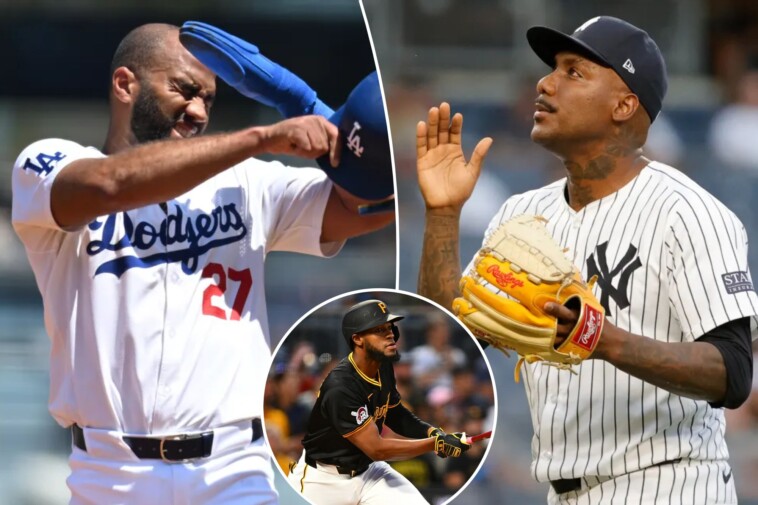The trade deadline is morphing into more of a time for auditions than blockbusters.
There were swaps that have uplifted teams — particularly in the NL West. But the leagues evolution to — among other items — a larger playoff field, no waiver trades in August and a general caution about dealing prospects has influenced more deals in which it seems teams are just seeing if something works and getting out of it quickly if it does not.
August has become a tryout camp, as already five obtained veterans have been designated for assignment: Enyel De Los Santos by the Yankees, Shawn Armstrong and Tommy Pham by the Cardinals, Trevor Richards by the Twins and Amed Rosario by the Dodgers. And two were demoted to the minors, the Mets’ Huascar Brazoban and the Orioles’ Trevor Rogers. Brazoban was subsequently recalled when another Mets’ trade deadline acquisition, Paul Blackburn, went on the IL.
Which emphasizes another pitfall for making deadline deals: There are just two months left, and even a brief IL stint cuts significantly into how much impact an acquisition can have. And at least a dozen players obtained at the deadline already have done or are doing IL time: Blackburn, Jazz Chisholm Jr., Alex Cobb, Zach Eflin, Luis Garcia, Yimi Garcia, Austin Hays, Hunter Harvey, Michael Lorenzen, Nick Mears, James Paxton and Lucas Sims.
I reached out to several executives and asked why there are so many more flyers on players at the deadline and so much less impact, and here are several theories:
1. It is a continuation of a cautious era in which front offices — even those involved in playoff races — are loathed to give up too much future value to try to win now. For every cavalier A.J. Preller, there are three or four executives who seem to think finishing atop the Baseball America organizational prospect rankings is the actual World Series.
“It’s certainly related to the general conservatism/risk-adverse behavior we’re seeing in July,” an AL talent evaluator said.
2. The expansion of the playoffs to six teams in each league has more teams in it around the deadline and at least, at the margins, trying to make acquisitions — even if they feel more like window dressing designed to convince their fan bases they are trying.
3. There is an impact being more fully felt now from two rule changes that are a few years old: 1) that rosters could only expand to 28 in September rather than as many as 40, and 2) the elimination of waiver trades in August.
The trade deadline is actually the non-waiver trade deadline. Until 2019, teams could still try to pass a player through revocable waivers in August and if successful that player could be traded. Without that process, buyers at the deadline are trying to guess at what they might need for the rest of the season.
So, for example, the Dodgers essentially trade a non-prospect to get control of a multi-positional player with skills against lefties such as Rosario, and, when they believe they have better alternatives, it does not heavily impact the Dodgers to quickly pivot away from Rosario.
“None of the guys [designated for assignment] make significant salaries and, candidly, aren’t that good, so the acquisition costs were low,” an NL executive said. “With rosters capped at 28 in September, it is harder to carry guys if they’re not performing. With no trade waivers [in August], teams have to make decisions at the end of July, so they potentially take on extra players and then are forced to make roster moves due to the 28-man September rosters.”
Conversely, teams that were contending in late July and saw that slipping away could try to cut salary by trading veterans in August in the age of the waiver trade. Without that, also-rans and even contenders who want to cut money or reshape their rosters will move the kind of veterans who teeter on the edge of 26-man rosters in late July.
In an extreme last year after the deadline, the Angels put a series of veterans on waivers in August hoping they would get claimed and drop them below the luxury-tax threshold, which worked. This August no team took that extreme a path, but plenty of players were thrown out on waivers to see if there were bites.
“We are seeing something unique to these times. Essentially we have a second deadline,” an AL executive said. “The first one is normal, albeit fear-based with prices high and teams under a lot of pressure given the wild cards. The second one has developed more as a money-drop deadline where teams are convincing themselves they’re doing veteran players favors while getting salary relief.”
With all of that, one month since the deadline — or roughly 50 percent of the time you have a new player in 2024, especially if a team fails to make the playoffs — losers and winners have emerged.
Chisholm — despite the IL stint and iffy defense at a new position, third base — has brought lefty pop and athleticism for the Yankees. But they already have moved on from De Los Santos while Mark Leiter Jr. has fallen out of Aaron Boone’s late-inning circle of trust.
For the Mets, Phil Maton and Jesse Winker have been good supplemental adds, Brazoban and Ryne Stanek not so much, and Blackburn had delivered three strong starts and two horrific ones before his injury.
But on the truly negative since, the deadline was July 30. Since July 31, the Pirates had the NL’s worst record and fell from contention, and their two attempts at improving the offense — Bryan De La Cruz and Isiah Kiner-Falefa – had combined for a .571 OPS in 201 plate appearances. Boston’s August ERA was 5.03, not helped by the acquisitions of relievers Luis Garcia and Lucas Sims, who combined for a 9.28 ERA in 22 games before both hitting the IL, where they are joined by Paxton.
Meanwhile, everything the Dodgers did, did not work, with Rosario gone and Kevin Kiermaier and Tommy Edman not providing much offensive impact, but Jack Flaherty has helped an injury-beset rotation with a 3.49 ERA in five starts while Michael Kopech had struck out 20 of 50 batters with a 0.63 ERA out of the pen.
On the subject of pens, the Padres added Jason Adam, Bryan Hoeing and Tanner Scott and that trio had a 1.50 ERA in 38 games. A.J. Puk had struck out 20 of 51 batters faced with a 0.66 ERA for the Diamondbacks, who also (especially initially) got a nice burst of power from Josh Bell at first to help ease the injury loss of Christian Walker.
Like with all trades, it will take years to know if buyers surrendered too much. But since the deadline, three of MLB’s four best records belong to the Dodgers, Padres and Diamondbacks.







